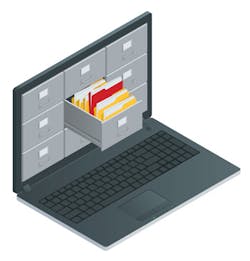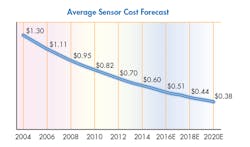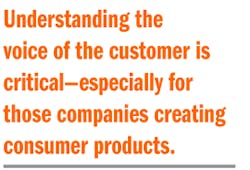Use Existing Data to Optimize IIoT Sensor Deployment
This file type includes high-resolution graphics and schematics when applicable.
Have you ever come home after a long day, hungry and tired, only to realize there is little to eat in the house? Perhaps you stared longingly into your pantry, hoping for inspiration, only to succumb to a radio advertisement and order a pizza with every additional topping raising the price.
Many websites have recently sprung up to help the hungry masses make use of available ingredients. If you have scrounged up some canned chicken, a carton of broth, frozen corn, and pint of leftover heavy cream, you can whip up a batch of chicken corn soup in 15 minutes flat. Voilà! No need to tip the pizza driver. The ingredients you had were more useful than they might have first appeared (who wants to eat plain canned chicken?), and just a little analysis and direction was all you needed to solve your hunger problem.
A similar situation exists for capital equipment suppliers, original equipment manufacturers (OEMs), and machine designers in the age of the Industrial Internet of Things (IIoT). Customers and stakeholders ask them to satisfy a growing hunger for data, data, and more data. Machine builders are asked to design in sensors and communications technologies.
It is hard to know where to start, and whether the solution being designed will be palatable to the end customer in terms of function and price. Rather than ordering highly marketed solutions from outside the enterprise and “tipping” consultants with exorbitant fees, they can find ingredients that are already on hand, apply basic analytics, and come up with some surprisingly tasty ways to translate raw data into process information to improve maintenance or business decisions.
Clearly machine manufacturers cannot put sensors on everything. Adding sensors takes considerable time, effort, and money. Costs can include processors, an embedded operating system, and one or more communication protocols—not to mention the software and infrastructure needed to receive and organize the data from the sensors. Machine designers are under pressure to create the most cost-effective products. They must prioritize critical characteristics to measure and incorporate sensors accordingly.
Many machine designers do not know where to begin. Luckily, the answer lies close at hand: Find out what your customer is hungry for, and (just as when you found plenty of ingredients for a nice meal) you might be pleasantly surprised to discover you already have plenty of relevant data. Analyzing that data to optimize the sensors on your machines is easier than you think. The key is knowing how to get started.
Steps for Locating and Optimizing Data
By taking the following steps, you can find and tap into useful data that will enable you to develop new equipment that optimally incorporates sensors.
Assemble your team
Start by gathering a cross-functional team of people in roles that affect the end result. Be creative. The more varied the perspectives on your team, the more ingredients you will have for success. For example, someone from the pricing team, or a supervisor in your assembly operations, might know things you do not. A user of pharmaceutical packaging equipment in Europe found a critical ingredient for their project by including the shipping-operations administrative assistant in the discussion. She maintained a report that provided a wealth of information not yet taken into account by the team.
Consider including:
• People who take the specifications from your customers.
• Customers who can talk about their experiences using your products.
• Customer service representatives who take support calls from customers.
• Staff handling warranties who know product failure rates and causes.
• Staff at your demonstration centers, if you have them. Results from test runs—even failed test runs—can be surprisingly valuable.
Collect data that will help you define the problem(s) you need to solve
Ask your team for information about problems and trends they’re seeing with regard to the health of the machine itself, and output from the machine.
Machine designers already collect considerable information about the health of their machines. Say you manufacture industrial baking equipment. You can find information about trends related to equipment operation and maintenance by looking at automatic fault code classification/categorization from technician’s notes and warranty claims. Doing so will help you figure out if an opportunity exists to put in a sensor to detect or prevent impending failures.
Finding trends in that data can be used to proactively optimize service. For example, you might learn that kneading operations cause more failure than baking operations. That provides a pointer regarding where to implement sensors and communications, using that information to minimize unplanned downtime and increase customer satisfaction.
Data about the output of the machine can answer questions about whether the machine meets a customer’s needs. In the case of baking equipment, your customer might care about whether it produces cookies of consistent texture and size. As a machine designer, you are more likely to have blind spots in this area.
For example, you may not be aware that ovens in northern climates are performing differently than those in more tropical environments—changes in the oven’s ambient temperature as cooler raw cookie dough heats up can affect the chewiness of the cookies. If that is an issue for your customer, you might design in communications or sensors related to factors external to the machine, such as ambient temperature or humidity. However, the only way you would know to do this is by first consolidating the data from a variety of customers.
You probably already have that data, in some format. Consolidating it and gaining insights from it is probably easier than you think given modern data-management and analytics tools.
Understanding the voice of the customer is critical—especially for those companies creating consumer products. Whether creating products for consumers or products for industry, many options are available for identifying customer sentiment. Ask the question: “What information do customers feel is missing in their process, and could a sensor address that issue?”
Taken a step further, you can survey customers about what analytics they are already performing and where gaps exist in their data. Another good source of data is inside requests for proposals (RFPs) and requests for quotes (RFQs). If you have enough of them, you can analyze a variety of factors in bids you lost, as well as those you won. This analysis might identify trends that point to missing capabilities addressable with sensors. And don’t forget social media sites, online forums, and the comments section on most websites; they are rich sources of untapped information in many cases.
This need not involve weeks of reading old documents. Text analytics is a robust field, and if you have this information in a machine-readable format, a text analytics package can highlight patterns and help you zero in on specific use cases that may drive value to your customers. Such analysis will help you start identifying new ways to sensor your equipment.
As you start identifying problems you can solve, focus on the worthiness of solving the problem. The answer to this question will determine how much time, effort, and money to devote to sensoring your equipment—or not. For instance, in one chemical manufacturing scenario, each failed batch cost the company at least $1 million. They were gratified to discover that excessive external humidity was the greatest predictor of batch failure. A simple, inexpensive humidity sensor was all that was required to move toward improving production outcomes.
Determine who will perform the analytics
Decide on who in your organization will execute data analysis. Some machine designers will want to empower in-house subject-matter experts who are not data scientists to analyze problems. Consider enabling customer-service representatives to perform sentiment analysis. Other companies might have someone with an analytical job title or educational background that enjoys working with data. Or you might want to work with a consultant who can help you use the most sophisticated data-analytics and build models.
Perform analytics on your existing data
While many people think you need to be an expert to perform data analytics, using these tools can actually be easier than you think. Tools are available that enable users with any level of analytics expertise to perform analytics without having to spend months correlating data in a spreadsheet and bringing it into an analytics platform or figuring out how to write algorithms.
Look for a vendor that offers a wide range of solutions. Start small, using simple visual analytics tools designed to allow business users to spot new patterns and identify key relationships, outliers, clusters, and trends to unearth hidden opportunities. Over time, gradually grow along the analytics maturity curve to perform sophisticated predictive analytics.
You also can employ text analysis tools to pull information out of the freeform text, such as RFPs/RFQs, warranty information, and service call records. Text analysis solutions allow you to easily examine key topics, identify highly related phrases, and observe how terms change over time. You save money and resources by automating the time-consuming tasks of reading and comprehending electronic text.
One manufacturer that has leveraged text analytics to improve product design is Lenovo, the largest global manufacturer of PCs and tablets, as reported by Forbes last year. Lenovo’s course of action illustrates how it pays to look outside of your immediate field to uncover examples of ways analysis can help your organization. Known as a manufacturer of consumer equipment, Lenovo wanted to use the data collected from its customers to shape their quality product development and product innovation—both its own and from outside its four walls. Text analytics enabled Lenovo to manage massive amounts of data and display it visually on a dashboard that shows customer sentiment, warranty, and call-center analysis.
One issue Lenovo discovered was a problem with docking stations. Customers were calling tech support to say they were having issues with the screen, or the machine was shutting down abruptly, or the battery was not charging. Similar accounts were turning up in social-media posts. Sometimes the customer mentioned docking. It was not until Lenovo used text analysis to analyze the combination of call-center notes and social-media posts that the word “docking” was connected to the problem, helping quality engineers figure out the root case and issue a software update.
Create and test your hypothesis
Performing data analytics on your existing data should help you come up with a much better hypothesis to determine where it might make sense to add sensors.
For example, your service records might reveal that when your machine is installed next to a motor, it tends to fail more quickly. You may then hypothesize that the issue is caused by vibration. You can now build a prototype with vibration sensors to test this hypothesis.
Regardless of whether or not your hypothesis is correct, you will still learn valuable information. If your hypothesis is correct, you will know what to sensor, and subsequently build that into future iterations of your machines. If it is incorrect, you can embark on an iterative process and go back to find more data. For instance, if your service records are not giving you enough insight, you might change your business processes. You can ask service staff to document the conditions under which they install equipment to gather data for testing a new hypothesis.
Conclusion
Industrial IoT is here to stay. Already, data from sensored equipment has shown value. Machine designers are being pressured to expand on this value. Yet, you are challenged to add sensors responsibly to maintain a reasonable cost point.
Luckily, as you prioritize what sensors to add, you have more data than you think and analytics tools that make it easier to exploit in your decision-making. Do not leave your customers hungry for smarter machines. By rummaging in your operations for data that you already have, and combining it in new ways for analysis, you will cook up new opportunities for profitability.
Marcia Elaine Walker is the principal industry consultant for manufacturing at SAS Institute. Follow her on LinkedIn or @MWEnergy on Twitter. Bill Roberts is the director of the Global IoT Practice at SAS. Follow him on LinkedIn or @w_j_roberts on Twitter. Follow SAS news @SASsoftware on Twitter.







